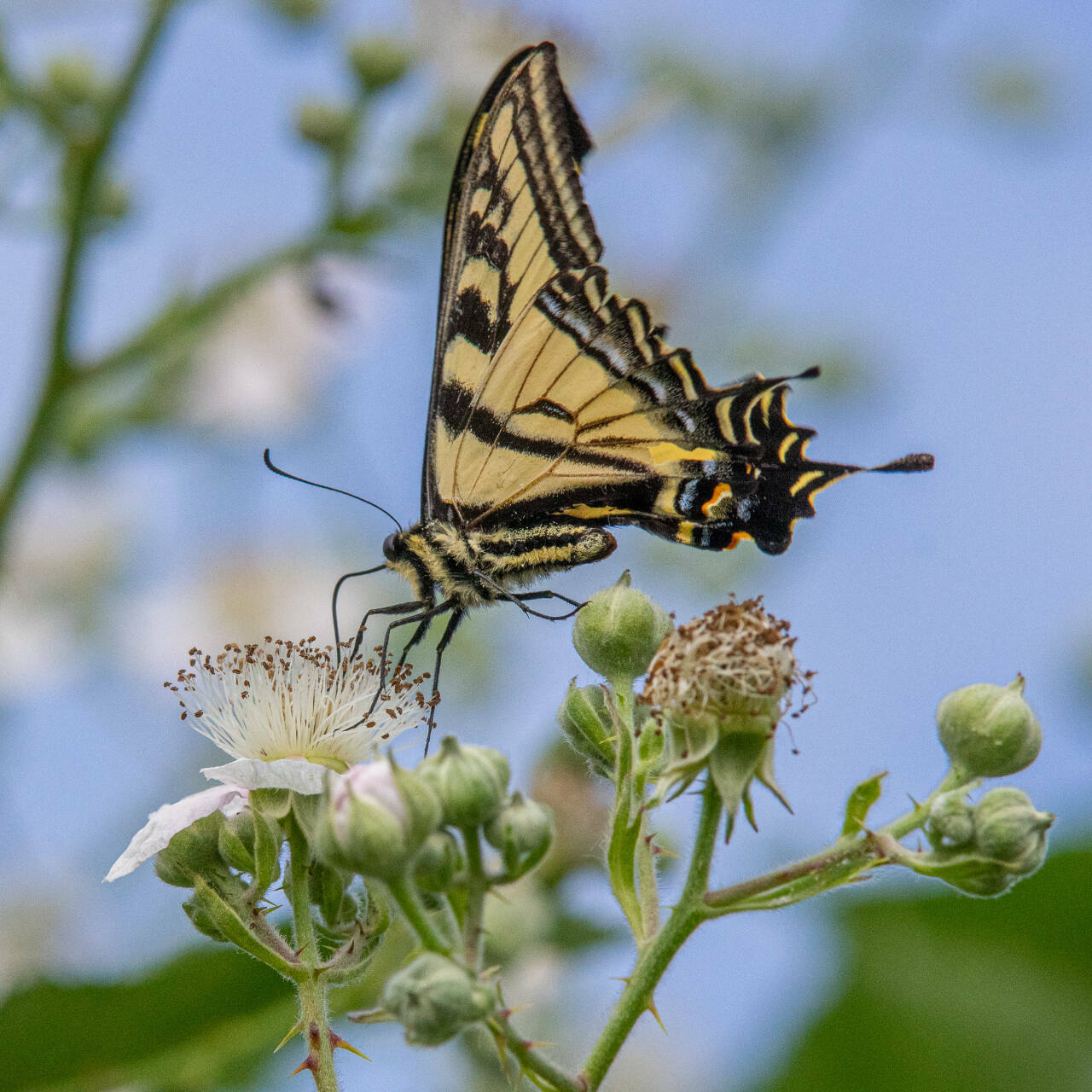By Emily Matthiessen
Olympic Peninsula
News Group
On soft, silent wings of black and yellow, Papilio rutulus — known also as the Western Tiger Swallowtail — float into our lives in late spring and early summer. Drinking nectar, fluttering into the trees, dancing in a spiral with others of their kind and encountering cars, they sometimes pause long enough for photographs that show the blue and orange on their lower wings and the tatters that speak to their short wild lives in adult form.
After a month or so for each individual living as an adult, they disappear.
Where do they come from and where do they go?
Actually, these butterflies are with us all year, in one of their four forms. Unlike the monarch butterfly, which they are often mistaken for, they are not migratory, says Lynwood-based lepidopterist David Droppers. “They are what we call a resident species, residing in the region their entire lives.
“After emerging from chrysalis, the males ‘patrol’ for mates, going back and forth along a transect. I have heard varying estimates in how far they patrol, hearing figures as far as 20 miles, but I don’t think sufficient research has been performed for us to be confident.”
Females have a smaller, less predictable range when searching for host plants to lay their eggs, which include many hardwood trees.
“Trees in the Salicaceae, such as willows and cottonwoods, are their favorites in this region, but they will use other trees, and likely specialize on other trees in other regions. Development of the eggs is primarily related to temperature, with warmer eggs maturing faster.”
After hatching, they may be in larval form for two to three months, “eating the leaves of their host plant.”
While birds and spiders are the primary predators of the adults, he says, “many creatures prey on the caterpillars; they’re a prize find for parents feeding hungry chicks.
”But a variety of invertebrates make meals out of caterpillars as well,” with only 2 percent of eggs commonly estimated to make it to adulthood.
Into maturity
After developing to their maximum larval size, says Droppers, the green larvae will turn brown and crawl down from their host. From there, they’ll go “walkabout,” searching for a place to pupate.
This species spends the entire winter as a chrysalis.
“They’ll ride out winter storms, freezing temperatures, endless rains … during a typical year, I expect to see the first males flying in mid-May,” he says. “[In] colder years we will see them flying later — there is no use in emerging during inclement weather.”
Because April started cold, says Droppers, “I expected to see them late this year, but May kicked things into high gear, and they emerged ‘on time’ …. We’ll see them into July during normal years, delayed into August during colder, late spring years.”
Males emerge before females, and females are around longer than males. He says this benefits both sexes: “The males have time to build their spermatophores, and the weaker males die before the females emerge, and the females get their last couple weeks of life without being pestered by the males, able to concentrate on laying eggs.”
Butterflies depend on sun and warmth.
“You won’t see many — if any — butterflies when it’s cloudy and raining,” Droppers notes. “They’re still there, just resting amongst the vegetation, trying to stay out of sight. They’ll return with the sun.”
Western Tiger Swallowtail butterflies are attracted to a range of flowers, including blackberries.
They “are far less picky as adults than they are as caterpillars,” Droppers says noting that though he usually advises gardeners to plant yellows, whites, and pinks/purples, as these colors reflect the most ultraviolet for pollinators, swallowtails seem to be attracted to the color red.
Observers of Western Tiger Swallowtails will see the butterflies interacting in a kind of spiral dance. Lepidopterist David Droppers said that if they quickly split, “the butterflies have figured out that they are both male. The male pursues the female when he has found one, often floating above her and wafting his pheromones. The females can begin to lay eggs immediately after mating. She’ll continue to lay eggs until she expires of old age or predation. Males die of old age or predation — they’ll mate as often as they can.”
“Watch at your local trailheads; they check out the cars’ brake lights.”
According to Droppers, they seem especially attracted to rhododendrons, both native and ornamental, as well as the native Mock Orange in drier sites.
There are about a dozen or so common species of butterflies in our region, Droppers says, including the cabbage whites and the “striking” Lorquin’s Admiral.
“It’s large, but never as common as the swallowtail, as these are extremely territorial and exhibit a ‘sentry’ style of mate-seeking, selecting a territory and flying out at any interlopers; they don’t move around as much as the swallowtails.”
Droppers suggests keeping an eye out for the Western Tiger Swallowtails’ less common relative, the Pale Swallowtail, which is paler.
“Western Washington is arguably one of the worst habitats in the world for butterflies, with exceptions like the higher mountain meadows giving us some diversity,” says Droppers.
“Lowland coniferous forest is simply not highly suitable.”
Only three species in our area — the Pine White, Cedar Hairstreak and Johnson’s Hairstreak — depend on conifers.
“Our wet and cold conditions are not conducive to our butterflies; we nickname ours the ‘mold butterflies’,” Droppers says. “But that makes the dozen or so common species the tough ones, able to thrive in a place where few other species are able.”
For more information about local butterflies, visit the Washington Butterfly Association at wabutterflyassoc.org.



